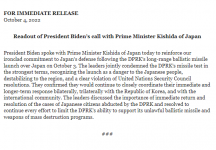You are using an out of date browser. It may not display this or other websites correctly.
You should upgrade or use an alternative browser.
You should upgrade or use an alternative browser.
ALERT The Winds of War Blow in Korea and The Far East
- Thread starter northern watch
- Start date
jward
passin' thru

EndGameWW3
@EndGameWW3
Update: Chinese Foreign Minister: Any move to obstruct China's reunification will be crushed by the wheels of history.
11:46 AM · Sep 24, 2022·Twitter Web App
onetimer
Veteran Member
North Korea has launched a suspected ballistic missile. More updates to follow.
View: https://twitter.com/JPN_PMO/status/1573798710995484672?t=VIk8GXsFDcycCqa_8ty4Ag&s=19
View: https://twitter.com/JPN_PMO/status/1573798710995484672?t=VIk8GXsFDcycCqa_8ty4Ag&s=19
northern watch
TB Fanatic
northern watch
TB Fanatic
northern watch
TB Fanatic
China using civilian ships to enhance navy capability, reach
China has been increasingly using civilian ships including hundreds of fishing trawlers to back up its vast territorial claims and project military powerBy DAVID RISING Associated Press
September 24, 2022, 4:44 AM
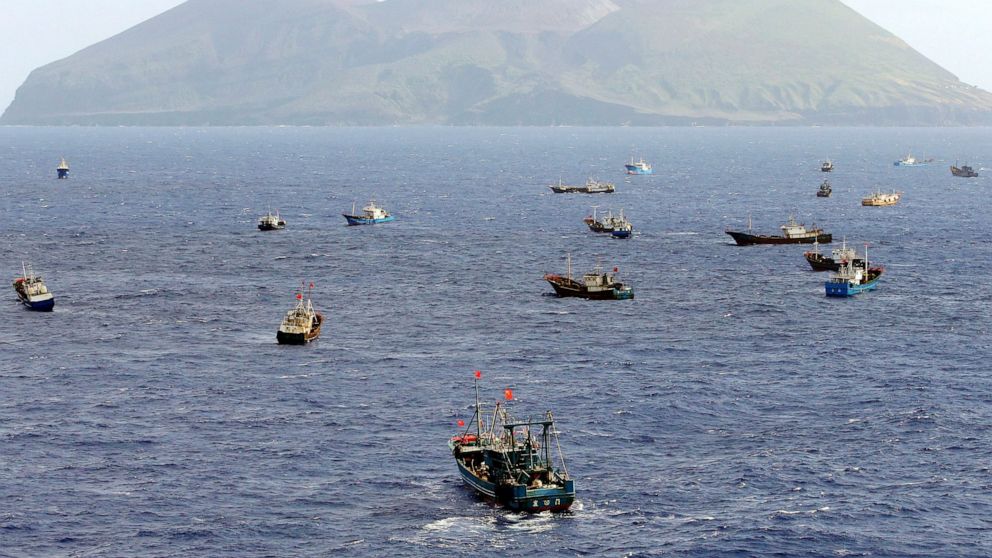
Foreign vessels, some of them have Chinese flags, fish near Torishima, Japan, on Oct. 31, 2014. A Chinese scientific ship bristling with surveillance equipment docked in a Sri Lankan port. Hundreds of fishing boats anchored for months at a time among disputed islands in the South China Sea. And ocean-going ferries, built to be capable of carrying heavy vehicles and large loads of people. (Kyodo News via AP)
The Associated Press
BANGKOK -- A Chinese scientific ship bristling with surveillance equipment docked in a Sri Lankan port. Hundreds of fishing boats anchored for months at a time among disputed islands in the South China Sea. And ocean-going ferries, built to be capable of carrying heavy vehicles and large loads of people.
All are ostensibly civilian ships, but experts and uneasy regional governments say they are part of a Chinese civil-military fusion strategy, little concealed by Beijing, that enhances its maritime capabilities.
China’s navy is already the world’s largest by ship count, and has been rapidly building new warships as part of a wider military expansion. It launched its first domestically designed and built aircraft carrier in June, and at least five new destroyers are on the way soon.
The buildup comes as Beijing attempts to exert broader influence in the region. It is increasing its military activities around the self-governing island of Taiwan, seeking new security agreements with Pacific islands and building artificial islands in disputed waters to fortify its territorial claims in the South China Sea, which the U.S. and its allies have challenged.
The civilian vessels do more than just augment the raw numbers of ships, performing tasks that would be difficult for the military to carry out.
In the South China Sea's Spratly Islands, for example, China pays commercial trawlers more than they can make by fishing simply to drop anchor for a minimum of 280 days a year to support Beijing’s claim to the disputed archipelago, said Gregory Poling, director of the Center for Strategic and International Studies’ Asia Maritime Transparency Initiative.
“China is able to use nominally civilian vessels that are clearly state directed, state paid to eat away the sovereignty of its neighbors, but then plausibly deny that the state is responsible,” he said.
China has been using civilian fishing trawlers for military purposes for decades, but has significantly increased the numbers recently with the creation of a “Spratly Backbone Fleet” out of a government subsidy program begun under President Xi Jinping, which helps cover building new vessels, among other things.
Those ships “largely appeared almost overnight” after China constructed port infrastructure a few years ago on the artificial islands it built in the Spratlys that could be used for resupply, Poling said.
Now there are about 300 to 400 vessels deployed there at any given time, he said.
The Philippines, Malaysia, Vietnam and others also have claims to the Spratly Islands, which sit in a productive fishing area and important shipping lane, and are thought to hold untapped reserves of natural gas and oil.
But the Chinese ships deter other trawlers from fishing in the area, and have been slowly displacing them from the grounds, with little that governments can do, said Jay Batongbacal, who heads the University of the Philippines' Institute for Maritime Affairs and Law of the Sea.
“Because they are ostensibly civilian fishing vessels, navies' ships are unable to deal with them lest China accuse the Philippines of provoking an incident and using force against civilians,” he said. “They take advantage of perceived ‘grey zones’ below the threshold for triggering a self-defense response.”
In one highly publicized incident, a steel Chinese trawler in 2019 rammed and sank a wooden-hulled Filipino boat at anchor northeast of the Spratly Islands, abandoning its crew to be rescued later by a Vietnamese fishing boat. Despite a diplomatic protest from the Philippines, China denied the incident was intentional, calling it an “accidental collision.”
In addition to about 800 to 1,000 commercial fishing boats in the Spratly fleet, China has approximately 200 other vessels as part of a professional maritime militia, according to a November study co-authored by Poling based on an analysis of official Chinese reports, satellite imagery and other sources.
The professional militia is better equipped, with trained crews and under direct state control, and is used for more aggressive operations such as harassing foreign oil and gas operations, Poling said.
In the event of a conflict, China’s use of civilian vessels would complicate the rules of engagement, he said.
“You don't want to treat every Chinese fishing boat as if it were an armed combatant, but, in fact, some of them may well be armed combatants,” Poling said.
China has also been deploying civilian research vessels for military-related tasks in areas where its navy would be unable to operate without provoking a response, said Ridzwan Rahmat, a Singapore-based analyst with the defense intelligence company Janes.
“If you deploy grey hull vessels, your adversary may also deploy a grey hull vessel as a reciprocal measure, so that makes it more dangerous for everyone,” he said, referring to the typical color of military ships. “So to avoid this, China has been deploying white hull vessels — to reinforce its presence without escalating things.”
There are also many Western export controls prohibiting sensitive technology from being sent to China for military use, which China is able to bypass by building such civilian ships, even though “in everything but name they’re military,” Rahmat said.
The autonomously piloted Zhu Hai Yun is believed to be one such ship, capable of launching airborne, surface and underwater drones “to carry out marine scientific research,” according to the Chinese state-run Global Times.
The ship, which completed its first autonomous sea trial in June, could also create military maps of the South China Sea floor, including important submarine lanes around Taiwan, Rahmat said.
“China has been increasing its submarine deterrent patrols, and in order to ensure it can do this it needs to map the underwater terrain,” he said.
China’s methods drew the ire of regional rival India last month when it sought to dock the Yuan Wang 5 in Sri Lanka’s Hambantota Port, not far from India’s southeast coast, for refueling at a time that New Delhi was preparing to test a new missile.
The vessel is officially a scientific research ship equipped with sensors that can be used to track satellites, but the same equipment can be used to gather data on a missile launch.
Sri Lanka, in the midst of an economic crisis and heavily reliant on aid from India, initially declined to allow the ship to dock over India's concerns.
But China operates the Hambantota Port, having been granted a 99-year lease on the facility — built with Chinese money — after Sri Lanka defaulted on loans in 2017. After high-level consultations with Beijing, Sri Lankan authorities backtracked and allowed the Yuan Wang 5 to dock from Aug. 16 to Aug. 22.
On Aug. 23, India successfully tested its new surface-to-air missile designed to defend a ship from close-range aerial threats.
“I suspect the launch was delayed until the Chinese spy ship was gone,” Rahmat said.
China hasn't tried to disguise its military use of civilian ocean-going ferries, which have had to meet defense standards since 2016 allowing them to accommodate military vehicles like tanks, said Mike Dahm, a retired U.S. Navy intelligence officer who has written on the topic for the U.S. Naval War College China Maritime Studies Institute.
Slickly produced state television videos showing trainloads of military vehicles and troops boarding the vessels and heading to sea, stating openly they are testing “how to use civilian transportation resources to execute military tasks.” The latest such exercise wrapped up earlier this month.
This could be meant to intimidate Taiwan, which China claims as its own and has not ruled out attempting to take by force, and also dovetails with the Chinese government’s message that the public is contributing to national security, Dahm said.
China at the moment does not possess enough amphibious craft to transport the number of troops needed 160 kilometers (100 miles) across the Taiwan Strait for a potential beach landing on the island, and the ferries could be a stopgap measure should a crisis prompt China to decide to invade, Rahmat said.
China also may not want to take on the expense of building and maintaining a “huge amphibious armada” for an indeterminate period of time, Dahm said.
Military amphibious craft are built to land troops and vehicles on a beach, whereas ferries provide port-to-port movement, which would mean they would only be effective if China can capture Taiwanese ports in serviceable condition, Dahm said.
Still, in a crisis, China's People's Liberation Army could attempt a chancy gambit like offloading amphibious vehicles from the ferries at sea or using floating causeways, Dahm said.
“There is always the possibility that the PLA could commit to a high-risk operation against Taiwan with the possibility of losing a large number of civilian ships,” he said.
———
Associated Press writers Jim Gomez in Manila, Philippines, and Ashok Sharma in New Delhi contributed to this story.

China using civilian ships to enhance navy capability, reach
China has been increasingly using civilian ships including hundreds of fishing trawlers to back up its vast territorial claims and project military power
jward
passin' thru

Insider Paper
@TheInsiderPaper
BREAKING: North Korea has fired ballistic missile ahead of VP Kamala Harris visit
5:29 PM · Sep 24, 2022·Twitter for iPhone
~~~~~~~~~~~~~~~~~~~~~~~~~~~~~~~

Global: MilitaryInfo
@Global_Mil_Info
1m
South Korea's, JCS, believe that North Korea fired a KN-23 (Iskander type-ballistic missile) - the missile performed an evasive & "pull-up" maneuver. SK's NSC has stated that they are interested in this launch due to NK's recent announcements of tactical nuclear weapons.
~~~~~~~~~~~~~~~~~~~~
N. Korea fires unspecified ballistic missile toward East Sea: S. Korean military | Yonhap News Agency
송상호
1-2 minutes
SEOUL, Sept. 25 (Yonhap) -- North Korea fired an unspecified ballistic missile toward the East Sea on Sunday, South Korea's military said, two days after a nuclear-powered U.S. aircraft carrier arrived here for allied drills.
The Joint Chiefs of Staff (JCS) provided no further details immediately.
The launch followed reports that Pyongyang seems to be preparing to fire a submarine launched ballistic missile (SLBM).
It marked the North's fifth missile firing since the Yoon Suk-yeol administration took office in May.
Pyongyang last fired eight short-range ballistic missiles in June.
The USS Ronald Reagan carrier strike group arrived in the southeastern port city of Busan on Friday to stage its first combined drills with the South Korean Navy in five years. The joint drills are set to take place in the East Sea later this month.

A news report on North Korea's launch of a missile is aired on a television at Seoul Station on May 7, 2022. (Yonhap)
Last edited:
jward
passin' thru
Radar Reflector-Covered Chinese Countermeasure Barge Emerges
Joseph Trevithick
Pictures recently emerged on social media of an interesting Chinese barge covered in various radar reflectors and antennas, and also equipped with a pair of Type 726-series defensive launchers that are used on various People's Liberation Army Navy warships. By all indications, the barge's main purpose is to support countermeasure and electronic warfare and related test and training activities, which could also support the development of new and improved weapons, sensors, and countermeasures. In some ways, it looks similar to decoy target barges that were used by Russia in efforts to protect the Kerch Strait Bridge in Crimea earlier this year.
It's unclear where or when the pictures were taken, but they show the catamaran-hulled barge fitted with more than 30 masts topped with radar reflectors of various shapes and sizes. Mesh screens, the purpose of which is not immediately clear but could be used to segregate certain RF frequencies, are seen hanging between a separate arrays of poles on the deck.
Chinese internetChinese Internet
In addition, it has two Type 726-series launchers, which can reportedly fire various types of countermeasures ranging from flares to small decoys with active radiofrequency jammers, one each on the port and starboard side of the craft.
A close-up look at the Type 726-series defensive launchers on the barge. Chinese internetA Type 726-series defensive launcher on one a Chinese Type 052D destroyer. Chinese internet
There are also a number of dome-covered antennas, types that are typically associated with satellite communications systems. These could be used to remotely operate or just monitor various onboard sensors and other systems, such as the Type 726s, as well as send information to other ships or land-based facilities for further analysis. The larger dome could be a radar or emitter of some type. There are at least three shelters on the deck, which might contain various equipment and generators to power onboard systems.
Personnel are seen on the barge's deck in the pictures, and there are racks of life raft canisters at one end, but it is possible it could operate uncrewed under certain testing circumstances. It also has a small pilothouse-like structure with windows at one end.
Racks of life rafts in cylindrical containers, as well as some of the antenna domes and one of the shelters on the barge, are seen in this close-up shot. Chinese internetThe structure with the windows seen at one end of the barge. Chinese internet
It's not immediately clear if this is the first outing for this type of barge, but the existence of the design, or at least a very closely related one, has been known since at least last year. A model of a barge with a nearly identical design was seen on display at the 2021 Zhuhai Airshow at a booth associated with the state-run China Aerospace Science and Industry Corporation (CASIC). The model at Zhuhai showed a much barer deck, suggesting that it is reconfigurable to meet the demands of specific test and training events.
More interestingly, the model at last year's Zhuhai Airshow appeared to have a pilothouse at one end and propellers at the opposite ends of its catamaran hull, showing it to be self-powered, at least to some degree. Whether or not any propulsion system is installed, or if it is operable, is unclear as there is a tug alongside that is helping to move it, although that really doesn't preclude it from being self-propelled in open waters.
A model of what appears to be the barge in question seen on display at the Zhuhai Airshow in 2021. Visible is the apparent pilothouse, to the right, as well as one of the propellers, at the left. Chinese internet
Though we don't know precisely what the purpose of this barge is, it is all but certainly a countermeasures and electronic warfare testbed. The model at the Zhuhai Airshow was shown alongside another model of a land-based, rail-mobile, ship-sized test and training platform that was described as being "a system for mimicking Blue Army electronic warfare threats." In Chinese military parlance, unlike in the U.S. military and most western armed forces, the "red" side represents friendly forces, while the "blue" side is the adversary. It can move along a long track to mimic a ship underway. You can read all about this elaborate land-based system here.
Satellite imagery last year confirmed that the rail-based system had been installed at China's Shuangchengzi missile test range in the Gobi Desert.
As is the case with the land-based platform, the barge is likely able to support the development and validation of new and improved Chinese naval countermeasures, including electronic warfare systems and payloads that can be launched from Type 726-series launchers, and various countermeasures used to defeat enemy capabilities in this regard. It would also be used to mimic various friendly and hostile capabilities for test and evaluation purposes, including to support the testing of new anti-ship missiles and sensors during developmental missions and training exercises. In this role, it can act as a non-destructive target and countermeasures platform with a reconfigurable signiture.
In addition, the barge and the rail-based system appear to be part of a larger push by the Chinese People's Liberation Army (PLA) to acquire large-scale countermeasures and electronic warfare-focused test and training assets to complement the country's already impressive and growing test and training infrastructure. A model of an unusual catamaran vessel was also at the CASIC booth at Zhuhai, which turned out to be a drone mothership ostensibly intended to help train Chinese naval forces to defend against swarms. That ship was launched in May 2021, but it is unclear if has since entered service.
A picture of the drone mothership test and training vessel at the time of its launch with an inset showing the model of the ship at Zhuhai in 2021. Chinese internet
All of this makes good sense as there is an 'arms race' of sorts in the electromagnetic spectrum going on in the Pacific, at least between China and the United States, and particularly in the naval realm. For instance, the U.S. Navy fielded at least multiple new electronic warfare systems over the last few years specifically on ships operating in the Pacific and in response to emerging threats emanating from China, which you read more about here and here. China, for its part, is making strides in this arena, as well.
The barge, or eventually ones like it, could potentially have operational applications, too. As noted earlier on, in July, the Russian Navy deployed some of its Project 436 target barges, which have a loosely similar configuration in terms of their arrays of radar reflectors, around the Kerch Strait Bridge. This bridge is a highly strategic link that connects Ukraine's Crimean Peninsula, which Russian forces have occupied since 2014, to Russia itself.
The ostensible purpose of these Russian barges appeared to be to help ward off any attacks by radar-guided missiles. Russia also subsequently installed radar reflectors around other bridges inside Ukraine for what were believed to be similar reasons. The effectiveness of these defenses in these particular contexts is highly questionable, as The War Zone has explored in detail in the past. However, it might still be possible to use similarly equipped decoy barges to help protect groups of friendly ships or critical infrastructure or to help create "ghost fleets" to confuse enemy forces.
If nothing else the radar-reflector-covered barge is another interesting indicator of the PLA's expanding array of countermeasures and electronic warfare-focused naval test assets, and the last of the three systems displayed in model form at the 2021 Zhuhai Airshow to become a reality.
Contact the author: joe@thedrive.com
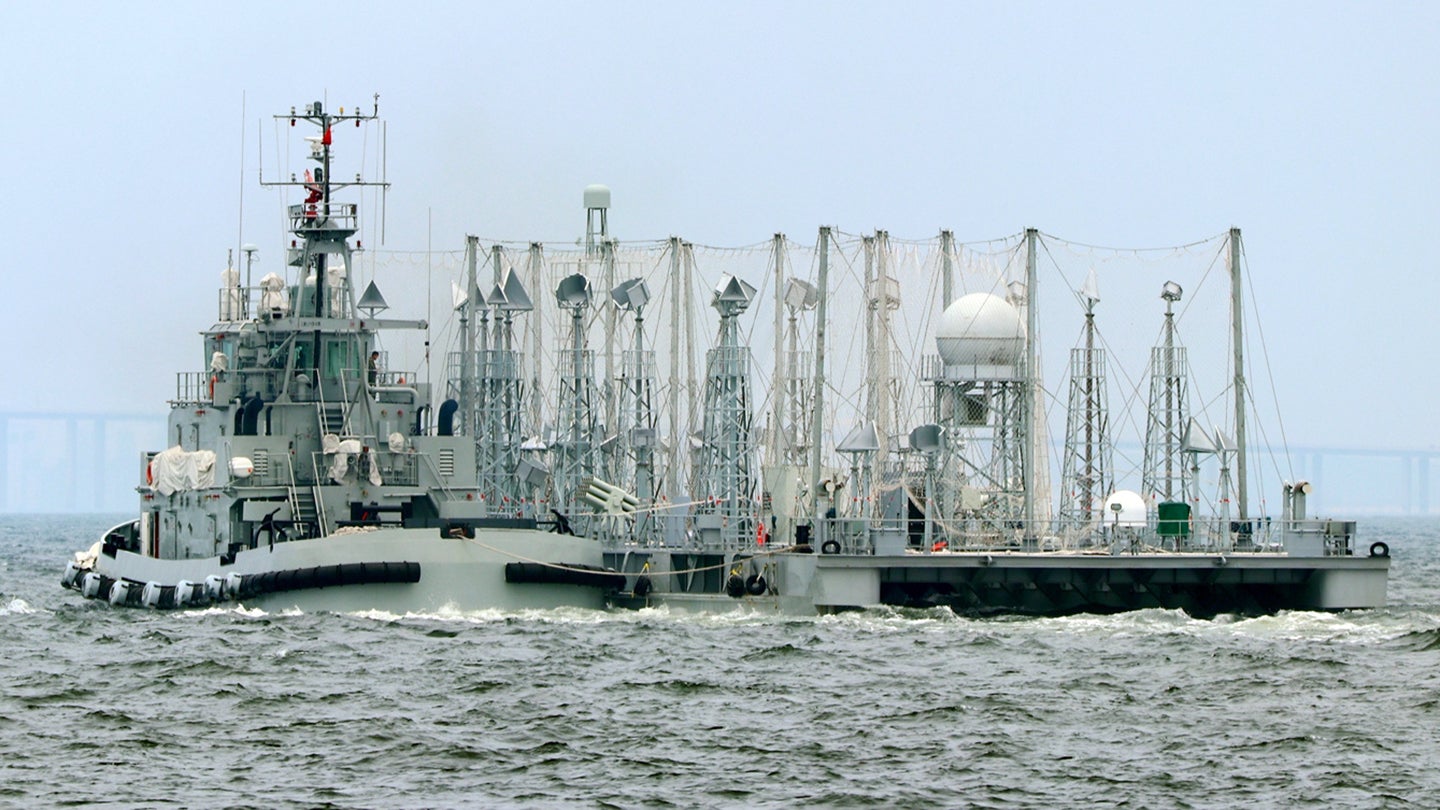
Chinese Countermeasure Barge Covered In Radar Reflectors Emerges
The barge, which is festooned with radar reflectors, antennas, defensive launchers, and other gear, first appeared in model form a year ago.
jward
passin' thru
Aaron-Matthew IL
@YangWL_
1h
“Either China or the US will want to seize the Philippines to be able to control the chokepoints and the access to Taiwan’ in the event of a conflict, Bautista added. ‘For the US it’s access for resupplying Taiwan, for China preventing that.”
Demetri Sevastopulo, Kathrin Hille
The Philippines and US are increasing military co-operation, including doubling the number of troops involved in joint exercises next year, as Manila starts to consider its role in a potential war with China over Taiwan.
The US and Philippines will next year send 16,000 forces to participate in Balikatan, their main annual bilateral military exercise, said Colonel Michael Logico, director of the Philippine military’s Joint and Combined Training Center, which recently hosted a planning conference with US counterparts.
“We are going to do a full battle test for operating together, including in Northern Luzon” near the country’s sea border with Taiwan, Logico said in an interview with the Financial Times.
At annual bilateral defence talks that will be hosted by US Indo-Pacific Command in Hawaii next week, military leaders will discuss more than 500 bilateral activities for the coming year, an increase from some 300 this year.
US defence secretary Lloyd Austin and Filipino defence minister Jose Faustino Jr will meet on Thursday — the first time defence ministers from the allies will join the talks, according to two people familiar with the event.
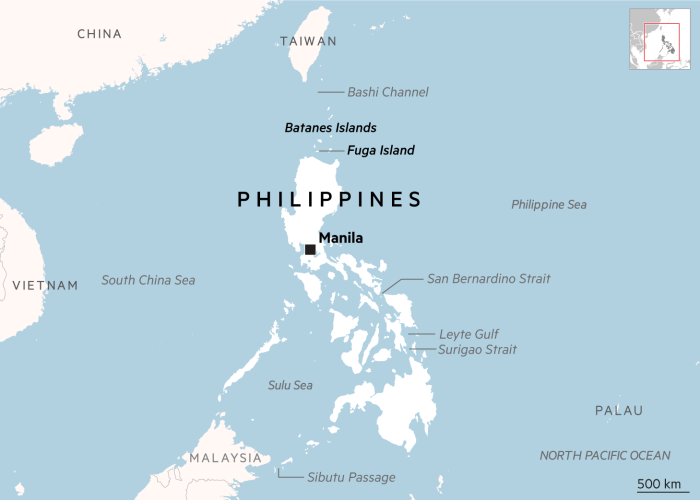
The stepped up co-operation comes after China’s increasing military activity around Taiwan unsettled senior Filipino officials and won their support for reinvigorating the country’s alliance with the US, which was weakened when then-president Rodrigo Duterte attempted a pivot to China in 2016.
In a meeting with President Ferdinand Marcos Jr in New York this week, Joe Biden said the relationship between the countries had “very deep roots”.
“We’ve had some rocky times, but the fact is it’s a critical, critical relationship, from our perspective,” the US president said. “I hope you feel the same way.”
Gregory Poling, a south-east Asia expert at CSIS, a Washington think-tank, said there was “a growing recognition of the role of the Philippines in a Taiwan scenario”.
“You’re starting to see a consensus emerge within most of the Philippines’ government that the Philippines does need to deepen the alliance with the US,” Poling said.
Other US allies have also grown worried about the risks that a Chinese attack on Taiwan would pose for them. In recent years, Japan has stepped up consultations, planning and drills with the US for such a scenario.
“We are a US ally, we are in a strategic location. We are so near that if anything happens in Taiwan we will be involved,” said General Emmanuel Bautista, former chief of staff of the armed forces of the Philippines.
Pointing to waterways connecting the South China Sea and the Pacific through the Philippines — such as the Bashi Channel in the north and the Sibutu Passage in the south — Bautista said the Philippines was “key terrain” for US-China competition because control of the country could give either side a marked advantage over its adversary.
Bautista said that navies used sea channels around the Philippines in the second world war to gain critical access for naval battles.
“Either China or the US will want to seize the Philippines to be able to control the chokepoints and the access to Taiwan” in the event of a conflict, Bautista added. “For the US it’s access for resupplying Taiwan, for China preventing that.”
One focus is on the islands in the Bashi Channel, only 120km from Taiwan at their northernmost point.
Lisa Curtis, an Indo-Pacific expert at the CNAS think-tank in Washington, said Manila was “wary of getting stuck in the middle of increasing US-China competition” but the new Marcos government seemed realistic about what Washington might request in the event of a Taiwan conflict.
“Washington would almost certainly look to Manila as a staging ground for logistics support and US forces. That is why it is important for the US and the Philippines to advance talks on the Enhanced Defense Cooperation Agreement,” said Curtis, in a reference to the 2014 bilateral agreement whose implementation has significantly slowed in recent years.
Last November, the two countries said they would explore additional sites in which US forces would be allowed a rotational presence — which experts understood to mean US forces could gain access to bases on those islands.
Logico said a Chinese company’s attempt to gain control of Fuga Island north of Luzon for a development project in 2019 — quickly stopped by the military — made the armed forces focus more on the north.
“The Chinese have no use for Fuga. It really is about Taiwan, to deny us, and in extension the US, the use of those islands,” Logico added.
Several current and former Filipino military officials said the Philippines would be the most suitable corridor for US forces to resupply Taiwan with munitions in wartime. According to two people in Manila familiar with the situation, Filipino and US forces have started discussing options for this.
Follow Kathrin Hille and Demetri Sevastopulo on Twitter
 www.ft.com
www.ft.com
@YangWL_
1h
“Either China or the US will want to seize the Philippines to be able to control the chokepoints and the access to Taiwan’ in the event of a conflict, Bautista added. ‘For the US it’s access for resupplying Taiwan, for China preventing that.”
US and Philippines increase military ties over China threat
Demetri Sevastopulo, Kathrin Hille
The Philippines and US are increasing military co-operation, including doubling the number of troops involved in joint exercises next year, as Manila starts to consider its role in a potential war with China over Taiwan.
The US and Philippines will next year send 16,000 forces to participate in Balikatan, their main annual bilateral military exercise, said Colonel Michael Logico, director of the Philippine military’s Joint and Combined Training Center, which recently hosted a planning conference with US counterparts.
“We are going to do a full battle test for operating together, including in Northern Luzon” near the country’s sea border with Taiwan, Logico said in an interview with the Financial Times.
At annual bilateral defence talks that will be hosted by US Indo-Pacific Command in Hawaii next week, military leaders will discuss more than 500 bilateral activities for the coming year, an increase from some 300 this year.
US defence secretary Lloyd Austin and Filipino defence minister Jose Faustino Jr will meet on Thursday — the first time defence ministers from the allies will join the talks, according to two people familiar with the event.

The stepped up co-operation comes after China’s increasing military activity around Taiwan unsettled senior Filipino officials and won their support for reinvigorating the country’s alliance with the US, which was weakened when then-president Rodrigo Duterte attempted a pivot to China in 2016.
In a meeting with President Ferdinand Marcos Jr in New York this week, Joe Biden said the relationship between the countries had “very deep roots”.
“We’ve had some rocky times, but the fact is it’s a critical, critical relationship, from our perspective,” the US president said. “I hope you feel the same way.”
Gregory Poling, a south-east Asia expert at CSIS, a Washington think-tank, said there was “a growing recognition of the role of the Philippines in a Taiwan scenario”.
“You’re starting to see a consensus emerge within most of the Philippines’ government that the Philippines does need to deepen the alliance with the US,” Poling said.
Other US allies have also grown worried about the risks that a Chinese attack on Taiwan would pose for them. In recent years, Japan has stepped up consultations, planning and drills with the US for such a scenario.
“We are a US ally, we are in a strategic location. We are so near that if anything happens in Taiwan we will be involved,” said General Emmanuel Bautista, former chief of staff of the armed forces of the Philippines.
Pointing to waterways connecting the South China Sea and the Pacific through the Philippines — such as the Bashi Channel in the north and the Sibutu Passage in the south — Bautista said the Philippines was “key terrain” for US-China competition because control of the country could give either side a marked advantage over its adversary.
Bautista said that navies used sea channels around the Philippines in the second world war to gain critical access for naval battles.
“Either China or the US will want to seize the Philippines to be able to control the chokepoints and the access to Taiwan” in the event of a conflict, Bautista added. “For the US it’s access for resupplying Taiwan, for China preventing that.”
One focus is on the islands in the Bashi Channel, only 120km from Taiwan at their northernmost point.
Lisa Curtis, an Indo-Pacific expert at the CNAS think-tank in Washington, said Manila was “wary of getting stuck in the middle of increasing US-China competition” but the new Marcos government seemed realistic about what Washington might request in the event of a Taiwan conflict.
“Washington would almost certainly look to Manila as a staging ground for logistics support and US forces. That is why it is important for the US and the Philippines to advance talks on the Enhanced Defense Cooperation Agreement,” said Curtis, in a reference to the 2014 bilateral agreement whose implementation has significantly slowed in recent years.
Last November, the two countries said they would explore additional sites in which US forces would be allowed a rotational presence — which experts understood to mean US forces could gain access to bases on those islands.
Logico said a Chinese company’s attempt to gain control of Fuga Island north of Luzon for a development project in 2019 — quickly stopped by the military — made the armed forces focus more on the north.
“The Chinese have no use for Fuga. It really is about Taiwan, to deny us, and in extension the US, the use of those islands,” Logico added.
Several current and former Filipino military officials said the Philippines would be the most suitable corridor for US forces to resupply Taiwan with munitions in wartime. According to two people in Manila familiar with the situation, Filipino and US forces have started discussing options for this.
Follow Kathrin Hille and Demetri Sevastopulo on Twitter
Subscribe to read | Financial Times
News, analysis and comment from the Financial Times, the worldʼs leading global business publication
 www.ft.com
www.ft.com
jward
passin' thru
Insider Paper
@TheInsiderPaper
18m
NEW North Korean nuclear weapons pose the greatest threat to Seoul despite the outbreak of war in Ukraine and growing tensions over Taiwan, South Korean President said in an interview
@TheInsiderPaper
18m
NEW North Korean nuclear weapons pose the greatest threat to Seoul despite the outbreak of war in Ukraine and growing tensions over Taiwan, South Korean President said in an interview
jward
passin' thru
Josh Smith
@joshjonsmith
46m
NEW: White House official confirms that VP Harris will visit the DMZ on the border with North Korea on Thursday. via
@TrevorNews
@joshjonsmith
46m
NEW: White House official confirms that VP Harris will visit the DMZ on the border with North Korea on Thursday. via
@TrevorNews
northern watch
TB Fanatic
jward
passin' thru
Was this yet another today/yesterday, or the same one I'd posted on... guess "just two" would still be a deescalation eh-
..not to mention the fact we've still not seen the nuclear one that has been promised/hyped for so long now.

jward
passin' thru
life is entirely too much interesting rhymin "fun" these days eh??
Apex
@Apex_WW
Nikkei: The Japanese Air Self-Defense Force and the German Air Force conducted their first exercise around Japan on Wednesday, as Berlin increases its involvement in Indo-Pacific security.
5:17 PM · Sep 28, 2022
·Twitter for iPhone
Apex
@Apex_WW
Nikkei: The Japanese Air Self-Defense Force and the German Air Force conducted their first exercise around Japan on Wednesday, as Berlin increases its involvement in Indo-Pacific security.
5:17 PM · Sep 28, 2022
·Twitter for iPhone
northern watch
TB Fanatic
Was this yet another today/yesterday, or the same one I'd posted on... guess "just two" would still be a deescalation eh-
..not to mention the fact we've still not seen the nuclear one that has been promised/hyped for so long now.
North Korea launches 2 ballistic missiles as Seoul says nuclear test is imminent
Pyongyang has launched 18 ballistic missiles and two cruise missiles in 2022.ByHakyung Kate Lee
September 28, 2022, 9:28 AM
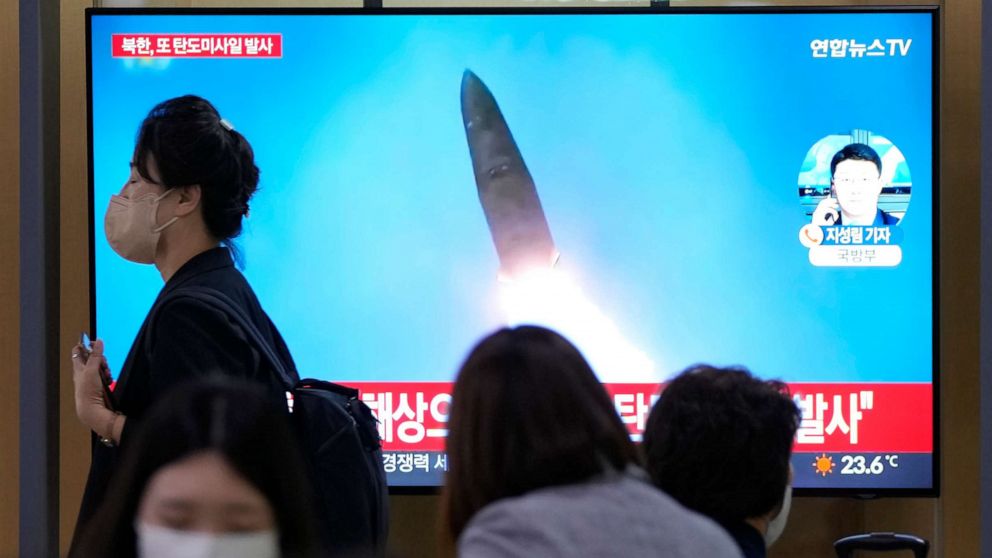
SEOUL, South Korea -- North Korea fired two short-range ballistic missiles toward the East Sea on Wednesday, just one day before U.S. Vice President Kamala Harris arrives in South Korea and amid speculation that North Korea is preparing to conduct its seventh nuclear test as early as October.
South Korean military detected two short-range ballistic missiles fired from the Sunan area in Pyongyang into the East Sea between 6:10 p.m. to 6:20 p.m. local time, according to South Korea's Joint Chiefs of Staff.
It’s the second ballistic missile launch in a week after North Korea test-fired one surface-to-surface short-range ballistic missile from the western inland town of Taechon on Sunday.

This file photo taken on on Sept. 9, 2022 shows file footage of North Korean leader Kim Jong Un on a television screen at a train station in Seoul, South Korea.
Anthony Wallace/AFP via Getty Images
South Korea’s Joint Chiefs of Staff immediately and strongly condemned the missile launch calling it a "grave provocation" that undermines peace and security on the Korean Peninsula as well as the international community. Pyongyang has launched ballistic missiles 18 times and cruise missiles two times so far in 2022.
“North Korea’s act of provocation will intensify the deterrence and response capabilities of the South Korea-U.S. ally and aggravate North Korea’s isolation from the international community,” South Korea’s Joint Chiefs of Staff said in a statement. “It’s a clear violation of the U.N. Security Council resolution and we urge North Korea to stop immediately.”
South Korean lawmakers told reporters that they believe North Korea has prepared an underground nuclear test site and that South Korean officials believe their neighbor to the north will undertake its seventh nuclear test sometime between Oct. 16 and Nov. 7, though these reports have not been confirmed.

A TV screen shows a file image of a North Korean missile launch during a news program at the Seoul Railway Station in Seoul, South Korea, on Sept. 28, 2022.
Ahn Young-joon/AP
“It’s become more plausible that North Korea will conduct a nuclear test as it readied the underground nuclear test tunnel,” Lawmaker Youn Kun-young said after a closed-door briefing with Seoul’s spy agency, the National Intelligence Service. “According to the NIS, there’s a high possibility that if North Korea does, it will happen between the 20th Party Congress of China on October 16 and before the U.S. midterm elections on November 7.”
Youn confirmed that the dates are only a reasonable guess and not confirmation of any specific intelligence.
“North Korea must give due consideration to its allies China and Russia,” Former NIS North Korea analyst Kwak Gil-sup told ABC News. “And dropping a nuclear security issue before the U.S. midterms may work favorably for China and Russia, both currently in political conflict with Washington.”

Vice President Kamala Harris talks to the media at Yokosuka Naval Base, in Yokosuka, Japan, on Sep. 28, 2022.
Leah Millis/Reuters
Another analyst suggested that although North Korea may be fully prepared to conduct a nuclear test, it does not necessarily mean that it will do so any time soon.
“When North Korea passed the new law enshrining its nuclear doctrine this month, it is to say that they have the nuclear weapons. North Korea has already proved its capabilities of successfully building a hydrogen bomb that could fit on the top of an intercontinental ballistic missile during its sixth nuclear test in September 2017,” Park Hwee Rhak, chair of the Nuclear Defense Committee at the Hansun Foundation, told ABC News. “If North Korea conducts yet another nuclear test it would only mean that they have improved the force or developed a smaller warhead, but I don’t see why they would go public with a strategic weapon.”
Both analysts, however, agreed about the unpredictable nature of North Korea.
“When it comes to North Korea, hours of analysis and speculation are always met with a surprise threat,” Park said.

North Korea launches 2 ballistic missiles as Seoul says nuclear test is imminent
North Korea fired two short-range ballistic missiles toward the East Sea on Wednesday, just one day before U.S. Vice President Kamala Harris arrives in South Korea.
vector7
Dot Collector
North Korea launches 2 ballistic missiles as Seoul says nuclear test is imminent
KAMALA HARRIS: "The United States shares a very important relationship, which is an alliance with the Republic of North Korea
RT 14secs
View: https://twitter.com/Orso_Dino/status/1575466465515421696?t=9nWF24ZdV9io0bzV9Cw6iA&s=19

vector7
Dot Collector
They (Biden Administration) sadly are incompetent,
they are not rational,
they don't make calculations,
they have no idea of de escalating,
and they are dangerous...
We saw it with Nord Streams and now with North Korea...
As Joe Tzu would say...
View: https://twitter.com/AZmilitary1/status/1575473834441965569?t=cg1z_z9U2MRT2enQJwVgrg&s=19
they are not rational,
they don't make calculations,
they have no idea of de escalating,
and they are dangerous...
We saw it with Nord Streams and now with North Korea...
As Joe Tzu would say...
View: https://twitter.com/AZmilitary1/status/1575473834441965569?t=cg1z_z9U2MRT2enQJwVgrg&s=19
northern watch
TB Fanatic
jward
passin' thru
N. Korea fires ballistic missile launch into East Sea: S. Korean military
All News 06:58 October 01, 2022
SEOUL, Oct. 1 (Yonhap) -- North Korea fired an unspecified ballistic missile into the East Sea on Saturday, South Korea's military said.
The launch marked the fourth round of provocation by the North this week.
(END)

 en.yna.co.kr
en.yna.co.kr
All News 06:58 October 01, 2022
SEOUL, Oct. 1 (Yonhap) -- North Korea fired an unspecified ballistic missile into the East Sea on Saturday, South Korea's military said.
The launch marked the fourth round of provocation by the North this week.
(END)

N. Korea fires ballistic missile launch into East Sea: S. Korean military | Yonhap News Agency
SEOUL, Oct. 1 (Yonhap) -- North Korea fired an unspecified ballistic missile into the East...
jward
passin' thru
Apex
@Apex_WW
1h
South Korean President Yoon: South Korea will strengthen joint military drills with the U.S.
South Korean President Yoon: South Korea will dramatically upgrade reconnaissance, strike capability against North Korea
South Korean President Yoon: North Korea will face overwhelming response by U.S. and South Korea if it tries to use nuclear weapons
@Apex_WW
1h
South Korean President Yoon: South Korea will strengthen joint military drills with the U.S.
South Korean President Yoon: South Korea will dramatically upgrade reconnaissance, strike capability against North Korea
South Korean President Yoon: North Korea will face overwhelming response by U.S. and South Korea if it tries to use nuclear weapons
jward
passin' thru
The Epoch Times - China Insider
@EpochTimesChina
The #SolomonIslands has joined 13 other Pacific nations in signing an 11-point partnership declaration with the US, despite initially refusing and requesting more time to review it.
View: https://twitter.com/EpochTimesChina/status/1576222906656464897?s=20&t=QbwFZfxgvuTlkKO13UauZg
@EpochTimesChina
The #SolomonIslands has joined 13 other Pacific nations in signing an 11-point partnership declaration with the US, despite initially refusing and requesting more time to review it.
View: https://twitter.com/EpochTimesChina/status/1576222906656464897?s=20&t=QbwFZfxgvuTlkKO13UauZg
jward
passin' thru
hmm. Still think, given enough time, they can take Taiwan without firing a single shot, much as the commie-red-rat-bastards took the USo'A. :: shrug ::

Indo-Pacific News - Geo-Politics & Military News
@IndoPac_Info
1h
On #China's national day (October 1st), some Taiwanese burn Chinese flags & some other Taiwanese celebrate China's day.
View: https://twitter.com/IndoPac_Info/status/1576223020774891520?s=20&t=QbwFZfxgvuTlkKO13UauZg

Indo-Pacific News - Geo-Politics & Military News
@IndoPac_Info
1h
On #China's national day (October 1st), some Taiwanese burn Chinese flags & some other Taiwanese celebrate China's day.
View: https://twitter.com/IndoPac_Info/status/1576223020774891520?s=20&t=QbwFZfxgvuTlkKO13UauZg
jward
passin' thru
Insider Paper
@TheInsiderPaper
ALERT Japan government says “seek shelter immediately” following reported North Korea missile
View: https://twitter.com/TheInsiderPaper/status/1577066109110403073?s=20&t=qcayWP28G1d_6fgNanIOrQ
BNO News
@BNONews
BREAKING: North Korean missile has flown over Japan, warning canceled, government says
5:44 PM · Oct 3, 2022
·TweetDeck
“missile passing. missile passing. The previous missile is believed to have passed into the Pacific Ocean around 07:29. If you find anything suspicious, do not approach it and immediately contact the police or fire department.”
@TheInsiderPaper
ALERT Japan government says “seek shelter immediately” following reported North Korea missile
View: https://twitter.com/TheInsiderPaper/status/1577066109110403073?s=20&t=qcayWP28G1d_6fgNanIOrQ
BNO News
@BNONews
BREAKING: North Korean missile has flown over Japan, warning canceled, government says
5:44 PM · Oct 3, 2022
·TweetDeck
“missile passing. missile passing. The previous missile is believed to have passed into the Pacific Ocean around 07:29. If you find anything suspicious, do not approach it and immediately contact the police or fire department.”
jward
passin' thru
| Ankit Panda @nktpnd Nuclear policy, Asia, missiles, & space. Stanton Senior Fellow, Carnegie Endowment for International Peace; Author of ‘KIM JONG UN AND THE BOMB’ (Hurst/Oxford) |

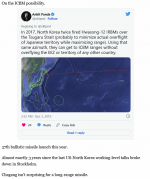


Thread by @nktpnd on Thread Reader App
@nktpnd: First since September 2017. IRBM or ICBM. On the ICBM possibility. 37th ballistic missile launch this year. Almost exactly 3 years since the last US-North Korea working-level talks broke down in Stockholm. C...…
jward
passin' thru
BNO News
@BNONews
38m
North Korean missile flew 4,600 km (2,860 miles) before falling in the Pacific Ocean, traveling further than any North Korean missile to date
Apex
@Apex_WW
South Korea’s Unification Ministry says NK unresponsive on inter-Korea hotline - Yonhap
8:52 PM · Oct 3, 2022
·Twitter for iPhone
@BNONews
38m
North Korean missile flew 4,600 km (2,860 miles) before falling in the Pacific Ocean, traveling further than any North Korean missile to date
Apex
@Apex_WW
South Korea’s Unification Ministry says NK unresponsive on inter-Korea hotline - Yonhap
8:52 PM · Oct 3, 2022
·Twitter for iPhone
danielboon
TB Fanatic
jward
passin' thru
hmm. worth watching to see what it turns out to have been. . .
Lokman Karadag 盧克曼
@LokmanKaradag1
Rumors are growing about an explosion around the Gangneung Airbase holding the 18th wing of the ROKAF.
View: https://twitter.com/LokmanKaradag1/status/1577339045080096768?s=20&t=7-0wbRaJnX37YdkBahE6wg
Lokman Karadag 盧克曼
@LokmanKaradag1
Rumors are growing about an explosion around the Gangneung Airbase holding the 18th wing of the ROKAF.
View: https://twitter.com/LokmanKaradag1/status/1577339045080096768?s=20&t=7-0wbRaJnX37YdkBahE6wg
jward
passin' thru
Yes. South Korea.
~~~~~~~~~~~~~~~~~~
Nathan is watching and analyzing, so a serious effort is being made to evaluate it:
Nathan J Hunt
@ISNJH
10m
Replying to
@LokmanKaradag1
Lokman I did search for webcams nearby found one webcam showing orange glow on horizon but not enough info if glow connected to reports or not
View: https://twitter.com/ISNJH/status/1577342839897624582?s=20&t=7-0wbRaJnX37YdkBahE6wg
~~~~~~~~~~~~~~~~~~
Nathan is watching and analyzing, so a serious effort is being made to evaluate it:
Nathan J Hunt
@ISNJH
10m
Replying to
@LokmanKaradag1
Lokman I did search for webcams nearby found one webcam showing orange glow on horizon but not enough info if glow connected to reports or not
View: https://twitter.com/ISNJH/status/1577342839897624582?s=20&t=7-0wbRaJnX37YdkBahE6wg
jward
passin' thru
Others addressing it: Guess all we know for certain in the moment is "something" probably happened, it's "probably" ok/under control at the moment, and "the world remains on edge"....

Faytuks News Δ
@Faytuks
13m
Reports of explosion(s) at Gangneug Airbase in South Korea. Seems to be a accident according to a military official https://cmcglr.com/news/articleVi
"An Air Force Headquarters official says It is true that it is an accident." There is speculations that a missile **could** have caused this. There is also some footage reportedly backing this claim. If that's the case, then it's a SK misfire during drills. Unconfirmed (!!)
Some speculations that the news is currently under an embargo, hence the lack of reporting
View: https://twitter.com/Faytuks/status/1577345295049965571?s=20&t=7-0wbRaJnX37YdkBahE6wg
Another report


Faytuks News Δ
@Faytuks
13m
Reports of explosion(s) at Gangneug Airbase in South Korea. Seems to be a accident according to a military official https://cmcglr.com/news/articleVi
"An Air Force Headquarters official says It is true that it is an accident." There is speculations that a missile **could** have caused this. There is also some footage reportedly backing this claim. If that's the case, then it's a SK misfire during drills. Unconfirmed (!!)
Some speculations that the news is currently under an embargo, hence the lack of reporting
View: https://twitter.com/Faytuks/status/1577345295049965571?s=20&t=7-0wbRaJnX37YdkBahE6wg
Another report

jward
passin' thru
The Intel Crab
@IntelCrab
An explosions has occurred within Gangneung Airbase, South Korea. The scope and scale of the damage here is unknown, but numerous fixed wing aircraft are stationed here.
View: https://twitter.com/IntelCrab/status/1577347543096344578?s=20&t=7-0wbRaJnX37YdkBahE6wg
@IntelCrab
An explosions has occurred within Gangneung Airbase, South Korea. The scope and scale of the damage here is unknown, but numerous fixed wing aircraft are stationed here.
View: https://twitter.com/IntelCrab/status/1577347543096344578?s=20&t=7-0wbRaJnX37YdkBahE6wg






